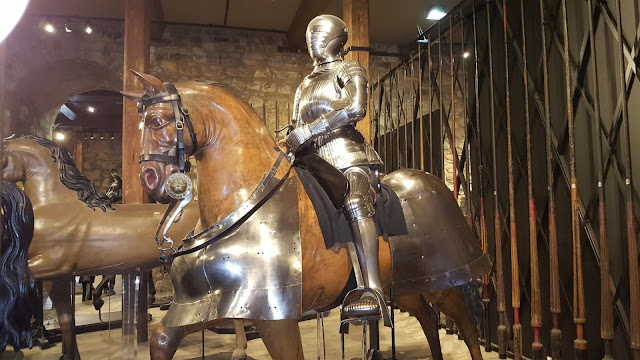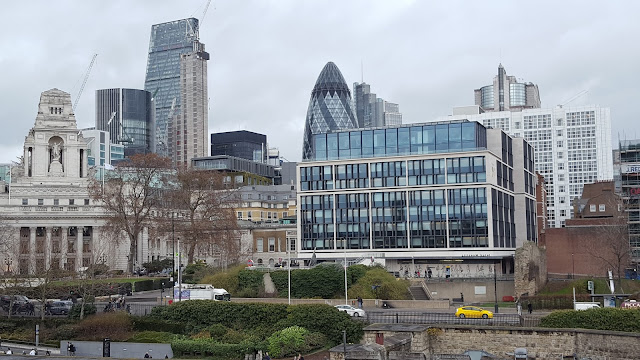 |
| Sunrise from our Hotel |
Merry Christmas day from London. Richard and I hope everyone is safe and has a joyous celebration today! We continue to enjoy our time in England. I'm a bit behind on the blog, but here is some of what we did two days before Christmas.
After breakfast on our third day, we took a taxi to Central London, ending up on the north bank of the Thames to tour the Tower of London (AKA Her Majesty's Royal Palace and Fortress of the Tower of London). We were able to see many of the nine towers and the two chapels.
After breakfast on our third day, we took a taxi to Central London, ending up on the north bank of the Thames to tour the Tower of London (AKA Her Majesty's Royal Palace and Fortress of the Tower of London). We were able to see many of the nine towers and the two chapels.
 |
| Our Beefeater |
Our tour started with a Yeomen Warder or "Beefeater" taking us on a brief walking tour, and explaining some of the history of the Tower. Richard had a long talk with our guide at the end of the tour who explained that Beefeaters are the ceremonial guardians of the crown jewels.
You might think that these are your average tour guides, but you would be wrong! The corps was started by King Henry VII in 1845. In order to be a candidate for these positions, you must have a minimum of 22 years of Armed Forces service, and also have received a "Long Service and Good Conduct" medal. One benefit of being a beefeater is that they are allowed to live in the Tower.
Getting a tour from a real beefeater added to the magic of being at the Tower. He was very friendly, funny, and knowledgable, and thinking about his service is impressive.
You might think that these are your average tour guides, but you would be wrong! The corps was started by King Henry VII in 1845. In order to be a candidate for these positions, you must have a minimum of 22 years of Armed Forces service, and also have received a "Long Service and Good Conduct" medal. One benefit of being a beefeater is that they are allowed to live in the Tower.
Getting a tour from a real beefeater added to the magic of being at the Tower. He was very friendly, funny, and knowledgable, and thinking about his service is impressive.
 |
| Tower of London, with Tower Bridge in the background |
The history of the Tower began in 1066AD when William, the leader of the Normans, conquered England and needed a castle in which to live when he was in London. This castle would need to protect him from not only invaders from other countries, but also from the English people who weren't thrilled about being conquered. Materials to build the castle included stone shipped on boats from France.
 |
| Building where the crown jewels are displayed |
The Crown jewels are stored here, and we got to see them up close. Unfortunately, we were not allowed to take pictures of them.
 |
| White Tower |
The White Tower is probably the most impressive of them all. The toughest part of touring this tower was the narrow, winding staircase. It is built in the Romanesque style, with narrow buttresses and rounded arches. Interesting fact: small toilets/latrines built into the wall are simply a board with a hole connected to a chute all the way to the ground. Hmm.
 |
| Armour displayed in the White Chapel; Wooden Horses are handmade |
 |
| Dragon Sculpture, White Tower top floor |
Real animals used to be kept at the Tower. In the 16th century this menagerie was open to the public as a form of entertainment. Later, in the 18th century, a price of admission was charged: either three half-pence or "the supply of a cat or dog to be fed to the lions"! In 1831, the animals were transferred to the London Zoo, as attitudes towards animal captivity had changed.
Artist Kendra Hastings created the monkeys below out of twisted, galvanised wire. The real Tower monkeys lived in a furnished room where visitors would be amused by their antics and human like behaviour. A guidebook from 1810 tells us that ‘formerly several monkeys were kept, but one of them having torn a boy’s leg in a dangerous manner they were removed’.
 |
| Monkey Sculptures |
 |
| Quarters |
 |
| Ceremonials Cannon |
The two churches located in the compound are called the Church of St. Peter ad Vincula (1520) and the Chapel of St. John's (1078). St. Peter's is a stand-alone structure and St. John's is on the second floor of the White Tower. We were not allowed to take pictures inside either building, so I stole a few from Google.
 |
| St. Peter's Chapel (organ on the left) |
Many monuments and memorials are contained in St. Peters, including burial places for some famous Tower visitors including three queens, the second and fifths wives of Henry the 8th, and many others. There is also a beautiful, old organ there.
 |
| St. John's Chapel; I love the stone work! |
St. John's is the oldest part of the fortress and was built as a keep or citadel (a protected area.) Its interior is made of impressive stone from France. There are simple carvings, and the arches are thick and curving. I really love the simplicity of this chapel.
 |
| A view of London from the Tower |
The Tower Bridge can be viewed from the Tower of London. To me it almost looks Disney-like, with it's bright colors. The bridge was first opened in 1894, but construction on it began in 1886. It stands 65 meters high and 244 meters in length. This famous bridge goes over the River Thames and we walked across it after we left the Tower. Here are some pictures of the bridge, taken on a dark, dreary London afternoon.
 |
| Tower Bridge |
Our time at the Tower ended as we walked across the bridge. We found a fun pub call The Bridge House and had lunch there and spent the rest of the day relaxing and swimming at the hotel. Ahhh....



No comments:
Post a Comment